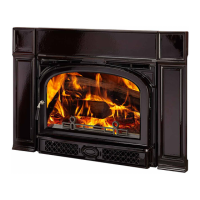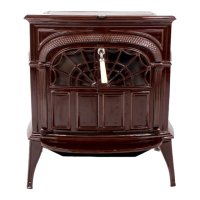
Do you have a question about the Vermont Castings Chateau DVT44 and is the answer not in the manual?
| Brand | Vermont Castings |
|---|---|
| Model | Chateau DVT44 |
| Category | Indoor Fireplace |
| Language | English |
Emphasizes reading the manual before use and provides critical warnings.
Outlines immediate actions and precautions to take if a gas leak is detected.
Covers essential safety points for installation, operation, and unit placement.
Highlights key considerations before and during initial fireplace operation.
Informs about chemicals known to cause cancer and reproductive harm.
Provides detailed measurements and framing requirements for the DVT38 model.
Provides detailed measurements and framing requirements for the DVT44 model.
Guides on choosing the optimal location for the fireplace, including corner and wall options.
Specifies minimum safe distances from combustible materials around the appliance.
Details requirements for installing mantels above the fireplace, including height and depth.
Suggests noncombustible hearth placement for aesthetic and safety purposes.
Explains how to frame the fireplace opening and prepare the wall for finishing.
Describes how to apply noncombustible finishing materials around the fireplace face.
Lists gas input ratings, pressures, and considerations for high altitude installations.
Details the steps and requirements for connecting the gas supply line.
Highlights critical safety warnings and precautions for gas line connections.
Outlines electrical connection and grounding standards, recommending licensed electricians.
Provides a step-by-step guide for installing the fireplace's electronic control system.
Identifies ports for testing gas inlet and manifold pressure and related cautions.
Guides on installing the optional battery back-up system for power outages.
Explains the function and activation of the continuous pilot mode for warming the firebox.
Specifies approved venting methods and general installation rules for balance.
Defines criteria for locating the vent termination hood to prevent obstructions.
Lists required clearances for vent termination in Canadian installations per CSA standards.
Lists required clearances for vent termination in US installations per NFPA standards.
Provides important notes regarding local codes and special venting system requirements.
Illustrates clearances needed for different termination configurations like corners and alcoves.
Offers a table for selecting the correct restrictor plate based on venting configuration.
Details the procedure for assembling SK8 venting pipes, including taping and securing joints.
Specifies requirements for horizontal vent runs, including maximum length and elbow usage.
Outlines rules for vertical vent termination, including minimum height and offset limits.
Explains limitations and requirements for sidewall venting to maintain system balance.
Describes the purpose of vent restrictor plates and their application in horizontal venting.
Guides on cutting and framing the opening in the wall for sidewall vent termination.
Details the installation of the zero clearance sleeve for combustible walls.
Covers securing the firestop and sleeve through the wall opening.
Explains how to attach vent pipes and elbows, including sealing and securing.
Details measuring horizontal length, sealing the termination, and supporting pipes.
Covers general approvals and requirements for vertical roof termination.
Explains the use and adjustment of restrictor plates for vertical venting configurations.
Illustrates support straps and rules for vent offsets in horizontal and vertical runs.
Provides a step-by-step guide for installing the vent system through the roof.
Shows how to install firestop spacers in ceiling and attic penetrations.
Illustrates the installation of an attic insulation shield for safety.
Details roof support installation and minimum termination clearance to the roof.
Lists components included in the horizontal starter kit for vent systems.
Describes SK8 chimney sections and various types of elbows available.
Lists firestop, zero clearance sleeve, and chimney support components.
Details components for terminating the vent at the roof or chase.
Provides guidelines for using and handling fireplace glass, including safety warnings.
Explains how to remove, clean, and re-install the fireplace glass frame.
Details the installation and adjustment procedures for restrictor plates and fresh air restrictor plates.
Offers advice on handling and installing fragile ceramic refractory panels.
Guides on installing restrictor plates and removing the rear log bracket.
Emphasizes careful handling of fragile logs and materials, keeping them away from children.
Provides a visual guide to identify each log piece for the DVT38 model.
Provides a visual guide to identify each log piece for the DVT44 model.
Details the placement of the log grate, burner overlay, and andirons.
Guides on how to place volcanic rock, lava rock, and ember material.
Instructs on correctly positioning the log grate and rear logs for the fireplace.
Details the placement of the front left and front middle left logs.
Guides on positioning the front middle right and front right logs.
Instructs on placing the front upper right and rear upper middle logs.
Explains how to visually inspect pilot and burner flames for correct appearance.
Illustrates correct flame patterns for DVT38 and DVT44 models.
Lists the components included in the trim kit for the fireplace.
Provides instructions for installing the top, bottom, left, and right trim pieces.
Lists critical safety warnings and procedures to follow before lighting the appliance.
Details the sequence of actions for safely lighting the fireplace using the remote.
Outlines the steps for safely shutting off the gas supply to the appliance.
Addresses problems with the control module learning the transmitter signal.
Troubleshoots issues where the pilot light fails to ignite or stay lit.
Helps diagnose why the main burner flame might not ignite.
Provides solutions for incorrect or reversed flame height adjustments.
Resolves problems with room temperature display and THERMO mode response.
Highlights safety warnings and necessary precautions before converting fuel types.
Details the sequential steps for converting the fireplace from natural gas to propane.
Guides on adjusting the gas control valve for different gas types and performing the conversion.
Explains how to check manifold pressure after conversion using a manometer.
Details methods for testing gas connections for leaks after installation or conversion.
Provides a table of orifice sizes for different burner configurations and gas types.
Lists required air shutter settings when converting the fireplace to LP gas.
Explains how to adjust the pilot flame for optimal burner ignition.
Instructs on cleaning the burner, burner compartment, and related components.
Covers cleaning the gas valve, pilot assembly, and making pilot flame adjustments.
Provides details on the optional back-up battery kit for the fireplace.
Lists available ceramic refractory kits and their descriptions for different models.
Outlines the basic, extended, and component warranties for the fireplace.
Specifies conditions for warranty validity, including installation and service requirements.
Details what is not covered by the warranty, such as misuse, transit damage, and external factors.
Explains how to obtain warranty service and the prohibition of self-service.
Presents the energy efficiency ratings for DVT38 and DVT44 models.
Recommends installation and service by NFI certified professionals.











